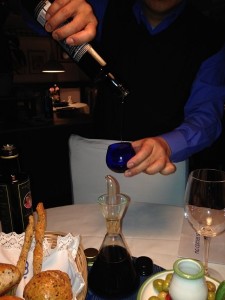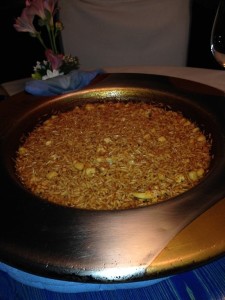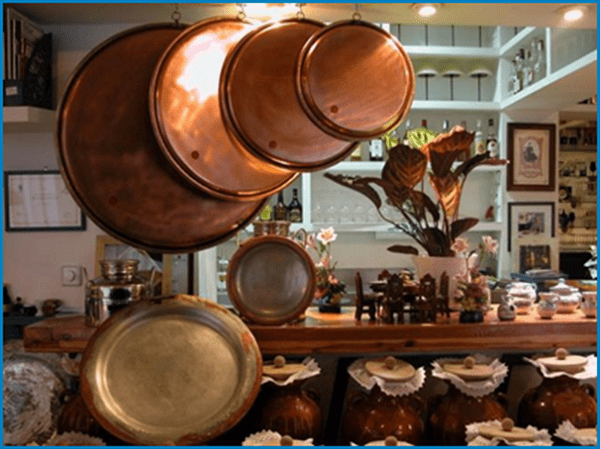By Chef Judi Gallagher –

A recent mini-vacation in Barcelona and Madrid (I met my husband in Spain for a week at the end of one of his European academic conferences) made me think that I could be happy living full time in beautiful, historic, vibrant, food-loving Barcelona. For museums and a different kind of city vibe there would be frequent trips to Madrid. Of course, I’d have to learn another language and I wouldn’t want to own a car in either city and I’d have to get used to eating dinner at 10 p.m each night, and I’d probably have to abandon my Paleo diet, because the paella in Spain is not something I could resist on a regular basis.
Seafood dishes are extraordinary in the bustling port city of Barcelona. In restaurants both large and intimate, you see platters of seafood emerging from kitchens that are works of art assembled with fresh-caught local fish, octopus, squid, crab, lobster, scallops, you name it. In Barcelona you will find amazing seafood that’s fried, salted, grilled, baked or served raw. If you order pica pica marinera, you’ll get a seafood mix of that particular restaurant and you can’t go wrong.

Cod fritters and fish stews are the specialties of many restaurants and some places prepare lobster using heritage recipes from the fisherman of Tabarca. Many seafood dishes are served with mashed yucca, but really rice reigns supreme as the accompaniment for seafood dishes. In many recipes, rice is an integral ingredient.
Which brings me to paella. I ate a lot of paella in Spain, so much in fact I’m thinking of myself lately as an expert.
Of all the restaurants serving paella that I tried in Spain, the one that I think every culinarian must try is Casa Benigna in Madrid. Located on an unobtrusive tiny street, regulars know it by the quaint door. Once run by his mother, Carmen, who still comes downstairs nightly from her apartment to greet diners, son Norberto Joge owns it now. Manager Eduardo took us on a Spanish tour of olive oils, 15 year old aged balsamic, which Carmel proudly boasts she distilled herself many years ago, and smoked rice; a feature for one of the paella dishes.
Those taste memories of Spain encouraged me recently to hunt down my big big paella pan on the highest shelf in the pantry (it takes up the whole shelf) and plan a paella party on my pool deck. The weather is perfect for al fresca dining and paella is a relatively easy one-dish meal to prepare. Shopping is the hardest part of making paella. And saffron is so expensive! I’ll serve my paella with a citrus salad, Spanish wine and maybe flan for dessert. Of course, Spanish music in the background. And yes, I even have some of the aged balsamic vinegar from Carmen.
Below is the paella recipe I’m using. With every bite, I’ll be thinking of Madrid and Barcelona. But I will probably be serving my guests dinner before 10 p.m. My travel tip is that if you’re traveling to Madrid, you must experience the paella at: Casa Benigna, Calle Benigno Soto 9, 28002 Madrid. Phone: 91 413 33 56 / 91 416 93 57.

Chef Judi’s Tips for Perfect Paella
The Sofrito
A sauté of aromatics, called the sofrito, provides the flavor base. The components of the sofrito vary by region. Tomato, onion, and garlic are a popular trio for the sofrito. Some cooks add pimenton, fresh herbs, or a dried sweet red pepper called ñora. The technique is simple; sauté the vegetables over medium-low heat until they soften and the flavors meld, and the water from the tomato has evaporated. This mixture should be thick enough to hold its shape in a spoon.

The Cooking Liquid
A flavorful liquid cooks the rice, while imbuing it with additional character. If you don’t have a homemade stock on hand, improvise one with the ingredients in the paella. For paella with shrimp, for example, simmer the shells in salted water for a quick, flavorful stock. If you use canned stock, choose a low-salt one. You can also use water, as many home cooks do in Spain. Almost every paella recipe calls for the liquid to be infused with saffron, which contributes color as well as a subtle background flavor to the rice.
The rice should be medium grain. Spanish rice is rounded and short; it absorbs liquid very well, and it stays relatively firm during cooking. Those qualities make it ideal for paella, where the rice grains absorb flavor from the liquid. The rice should be dry and separate when done, not creamy like risotto. The most prestigious variety of Spanish rice is bomba, but there are other imported varieties, such as valenciano, work as well as bomba. This recipe for paella is excellent and one that I use when I make paella.
Paella

(courtesy of Alton Brown. Serves 6-8)
1 pound tomatoes
9 cups low-sodium chicken broth
3 cups short or medium-grain rice
20 threads saffron
2 sprigs rosemary, leaves stripped from sprigs
3 teaspoons kosher salt, divided
1 teaspoon smoked sweet paprika
2 tablespoons olive oil
3 pounds bone-in, skin-on, chicken thighs and legs
1/2 pound fresh green beans, trimmed and halved
1 cup chopped red bell pepper
1/2 cup chopped green bell pepper
2 cloves garlic, minced
Special equipment: Chimney starter, newspaper, vegetable oil, and 4 pounds natural lump charcoal, 15-inch carbon steel paella pan
Spritz 4 to 5 pieces of newspaper with vegetable oil and put in the bottom of a charcoal chimney starter Fill the chimney with half of the charcoal and light the newspaper. When the charcoal is lightly covered with gray ash carefully pour onto the bottom grate of a kettle grill and spread evenly. Top with the remaining unlit charcoal, spreading evenly so as not to suffocate the lit charcoal. Set the second grate in the kettle and cover until ready to cook.
Meanwhile, halve the tomatoes and remove the seeds to a fine mesh strainer set over a small bowl to catch the juice. Grate the seeded halves on the large hole side of a box grater and discard the skins. Combine the reserved juice and grated tomato and set aside.
Warm the chicken broth in a kettle or 4-quart saucepan over high heat until it reaches 200 degrees F. Remove the broth from the heat and cover to keep warm.
Combine the rice, saffron, rosemary, 1 teaspoon of the salt, and paprika in a small mixing bowl. Heat the olive oil in the paella pan on the prepared grill. Season the chicken on all sides with the remaining 2 teaspoons of salt. Once the olive oil shimmers, add the chicken and cook until golden brown on both sides, approximately 5 to 6 minutes per side. Move the chicken to the outer edges of the pan. Add the green beans, red bell pepper, green bell pepper and garlic to the center of the pan and cook until they begin to soften and darken in color, approximately 2 to 3 minutes.
Add the tomatoes and their juice and cook until most of the liquid has dissipated and the tomatoes thicken and darken, approximately 4 to 5 minutes. Add the rice mixture to the center of the pan and cook, stirring constantly for 1 minute.Redistribute the chicken pieces on top of the rice. Add 4 cups of the warm chicken broth and stir to distribute the rice evenly in the pan, making sure that all rice is completely submerged in liquid. From this point forward do not stir the paella.
After 8 to 9 minutes, when all of the liquid is absorbed and the rice appears dry, add an additional 4 cups of broth. Continue to cook without stirring, until the liquid is absorbed, about 8 to 9 minutes. The rice should be firm to the bite and the grains have a tiny white dot in the center. Add the remaining cup of broth as needed, until the rice is cooked through. Watch the fire to make sure it is heating evenly and adjust the pan to prevent uneven cooking. Remove the pan from the heat, cover with a tea towel and rest for 15 minutes before serving.
F&M
